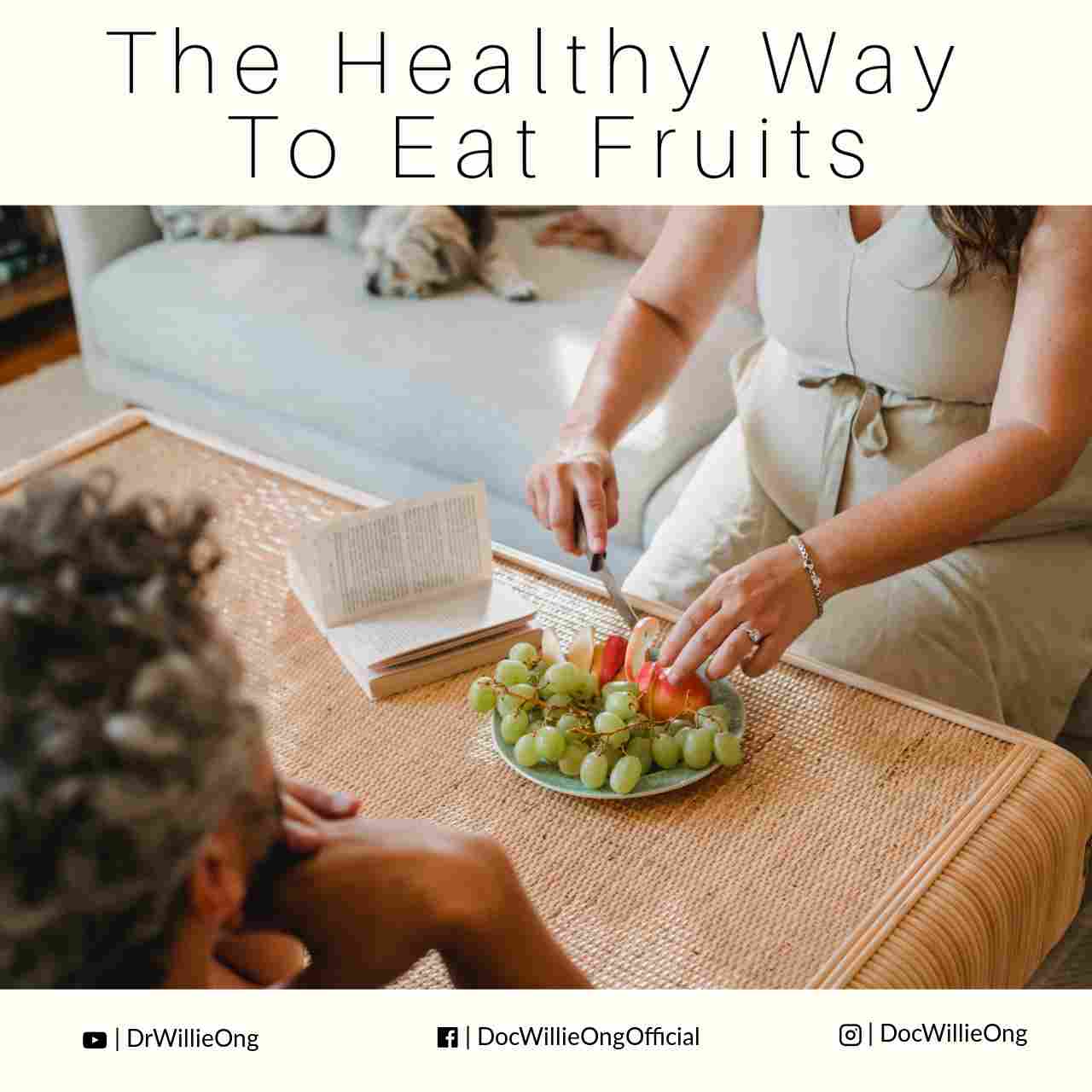Dr. Willie T. Ong (Internist-Cardiologist)
Although fruits are very healthy and rich in vitamins and fiber, too much of a good thing can also pack added pounds to your waistline.
As always, moderation is the key word. Don’t eat too much of any one thing. Not too much wine, too much fats or too much eggs.
In fact, some of my patients consume one mango per meal, and then act surprised when they gain four pounds in a month.
Comparing between fruits and vegetables, fruits have almost three times the calories compared to veggies. Therefore, it is a mistake to think of fruits as an “all-you-can-eat” food. The only zero calorie food is plain water.
Fruits also contain a type of sugar called fructose, which is healthier than white sugar. But still, fructose will bring in added calories, which is 40 calories per ten grams of sugar. Take note of these tips:
Tip No. 1: Limit eating dried fruits.
If you look at our fruit-calorie table (below), you will notice that dried fruits, like raisins, have much higher calories per serving size. This is because they are concentrated and sugar-packed fruits. The process of drying fruits is by removing all the water while retaining all the sugar and calories. That is why half a cup of raisins will cost you 219 calories (more than a cup of rice), while a medium-sized apple only has 70 calories. So which will make you feel fuller, a half-cup of raisins or three apples? If you’re on a diet, go for fresh fruits and vegetables.
Tip No. 2: Limit eating canned fruits.
Canned fruits are usually soaked in rich thick sugary syrups, and this is what can make you fat. Actually, fresh fruits are much healthier because they already have their own natural sugar. You really don’t need to add sugar, condensed milk or ice cream on top of your fruit. If you like canned fruits, then you can drain as much of the syrup and just eat the fruit.
Tips No. 3: Don’t add sugar or syrup to your fruit shake.
My favorite fruit shake is the anti-cancer blend of apple, carrot and cinnamon (without the syrup), which I take twice a week. Before, I used to blend a fruit shake everyday, but this made me gain weight so I stopped it. Hence, drink fruit shakes in moderation because they have concentrated amounts of natural sugar. In addition, some of the important fiber components of fresh fruits are discarded when you use a “juicer.”
Tip No. 4: Choose the right fresh fruits.
If you’re weight-conscious, then apples, melons, watermelons, bananas and strawberries are good for you. Melons are a bit high in sugar, but they’re mostly water and therefore lower in calories per serving size. And although a medium-sized banana has about 100 calories, they can still make you feel fuller and less hungry. Because of this, the Japanese people have used banana as their diet fruit.
On the opposite side, grapes, mangoes, avocados and prunes are relatively higher in calories.
Tip No. 5: Limit yourself to three to four fruit servings a day.
Nutritionists advise us to limit our fruit servings to an average of three to four servings per day. Take note: One serving of fruit is equal to approximately one medium-sized fruit, one-half cup of fresh fruit, one-half glass (four ounces) of 100% fruit juice or one-fourth cup dried fruit. Moreover, a banana, an apple, 12 grapes, five large strawberries and a slice of mango will constitute one serving already. Children are encouraged to eat two servings of fruits a day. Physically active, taller and large-framed individuals may take in more fruits. However, shorter and thinner persons can take in fewer servings in a day.
Tip No. 6: Eat more vegetables.
As mentioned, vegetables only have one-third of the calories of fruits. Therefore, you are allowed to eat more of your favorite vegetables, like cabbage, lettuce, ampalaya, kangkong, spinach and broccoli without gaining weight.
Indeed, fruits are very healthy and they are an essential part of our diet. However, we should choose the right kind of fruit, and eat just the right amount for our health.
| FRUIT | SAMPLE SIZE | NUTRITIONAL VALUES | CALORIES |
| Apple-Fresh | 1 medium with skin | Low in fat; moderate in calories. Contains pectin which is a fiber component that fights cholesterol. | 72 |
| Avocado | 1 medium | High in monounsaturated to help fight cholesterol, but also high in calories. | 322 |
| Banana-Fresh | 1 medium | Vitamin C, B6 and potassium. | 105 |
| Cantaloupe | 1 cup | Excellent source of Vitamins A and C. | 53 |
| Melon | 1 cup | Low in calories; source of iron. | 48 |
| Cranberries | 1 cup | Low in fat and calories. | 44 |
| Grapes | 1 cup | Good source of Vitamin C. | 106 |
| Guava | 1 Fruit, medium | Loaded with Vitamin C | 37 |
| Honeydew Melon | 1 cup | Low in calories; high in Vitamin C. | 60 |
| Kiwi | 1 medium | Moderate calories; rich in Vitamin C. | 46 |
| Lemons | 1 small | Rich in Vitamin C. | 17 |
| Mango | 1 slice | Low in calories and fat. Great source of fiber. | 107 |
| Orange | 1 medium | Fantastic source of Vitamin C. | 62 |
| Papaya | 1/2 medium | Low in calories and sodium. Contains beta-carotene to help prevent cancer. | 59 |
| Pear-Fresh | 1 medium | Low in calories; high in Vitamin C. | 98 |
| Pineapple | 1 cup | Good source of dietary fiber. Rich in Vitamin C. | 76 |
| Prunes | 5 medium | Super fiber source. | 100 |
| Raisins | 1/2 cup | Great source of fiber and iron. | 219 |
| Strawberries | 1 cup | Very low in calories. | 45 |
| Watermelon | 1 cup | Low in calories; contains some fiber; fair amount of Vitamin C. | 51 |
Note: One serving of fruit is equal to approximately one medium fruit, half-cup of fresh fruit, four ounces of 100% fruit juice, or one-fourth cup dried fruit. Source: www.dietbites.com/Fruit-Calories.html



